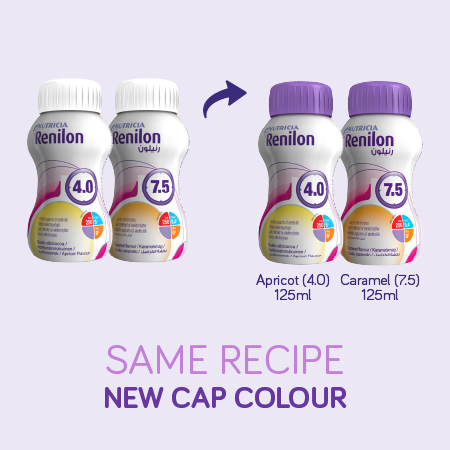

Product Information
A ready-to-drink, high energy, moderate protein, reduced mineral oral nutritional supplement for the dietary management of patients with renal disease (receiving dialysis).
Link copied!
Indications
For the dietary management of:
- Disease-related malnutrition.
- Patients with renal disease receiving dialysis treatment.
- Patients requiring a fluid or volume restriction.
- Patients requiring a select mineral restriction.
Important Notice
- Not suitable as a sole source of nutrition.
- Not suitable for parenteral use.
- Not suitable for patients with galactosaemia.
- Not suitable for patients with cow’s milk protein allergy.
- Not suitable for infants and children under 3 years of age.
- Use with caution in children aged 3 years+.
- Must be used under medical supervision.
Direction for Use
- Shake well before use.
- Best served chilled.
- Usage to be determined by a healthcare professional.
Storage
- Store in a cool, dry place.
- Once opened, close the bottle and store in a refrigerator for maximum 24 hours.
Order Information
To order Contact Nutricia Experience 1800 889 480
| Renilon 7.5 | Presentation | Code | Units per carton |
| Caramel | 125ml bottle | 177025 | 24 |
Ingredients
Full ingredients list and nutritional information is available on the product fact sheet.
Allergen & Cultural Information
- Contains milk and soy.
- Halal certified.
- Nutricia UK and/or Ireland has Kosher approval for this product.
- No gluten containing ingredients. No detectable gluten when tested to a sensitivity level of less than 5 parts per million (<5 ppm i.e. <5mg/kg).
- Low lactose (lactose <2g/100g).
References
- Herselman M, Moosa MR, Kotze TJ, Kritzinger M, Wuister S, Mostert D. Protein-energy malnutrition as a risk factor for increased morbidity in longterm hemodialysis patients. J Renal Nutr 2000; 10: 7-15.
- Drai J, Bannier E, Chazot C, Hurot J et al. Oxidants and antioxidants in longterm haemodialysis patients. Farmaco 2001; 56: 463-65.
- Morena M, Cristol J, Canaud B. Why hemodialysis patients are in a prooxidant state? What could be done to correct the pro/antioxidant imbalance. Blood Purif 2000; 18: 191-99
- Loughrey CM, Young IS, Lightbody JH et al. Oxidative stress in haemodialysis. QJM 1994; 87: 679-83.
- Toborek M, Wasik T, Drozdz M, Klin M et al. Effect of hemodialysis on lipid peroxidation and antioxidant system in patients with chronic renal failure. Metabolism 1992; 41: 1229-32.
- Chen CK, Liaw JM, Juang JG, Lin TH. Antioxidant enzymes and trace elements in hemodialyzed patients. Biol Trace Elem Res 1997; 58: 149-57.
- Paul JL, Sall ND, Soni T et al. Lipid peroxidation abnormalities in hemodialyzed patients. Nephron 1993; 64: 106-109.
- Stratton R. Rationale for the addition of carotenoids to enteral tube and sip feeds. Nutricia Healthcare 2000, on file.
- Ghoreshi Z, Jagtap PE, Ahaley SK, Gandhi R. Oxidant-antioxidant status in acute and chronic renal failure. Indian J Med Sci 2000; 54: 131-135.
- Jackson P, Loμghrey CM, Lightbody JH, McNamee PT, Young IS. Effect of hemodialysis on total antioxidant capacity and serum antioxidants in patients with chronic renal failure. Clin Chem 1995; 41: 1135-38.
- Fiorillo C, Oliviero C, Rizzuti G et al. Oxidative stress and antioxidant defenses in renal patients receiving regular haemodialysis. Clin Chem Lab Med 1998; 36: 149-153.
- Bender DA, Bender AE. Nutrition. A reference handbook. Oxford: Oxford University Press, 1997.
- Okada A, Takagi Y, Nezu R, Sando K, Shenkin A. Trace element metabolism in parenteral and enteral nutrition. Nutrition 1995; 11(Suppl): 106-11
- Muth I. Implications of hypervitminosis A in chronic renal failure. J Renal Nutr 1991; 1: 2-8.
- Khan IH, Richmond P, Macleod AM. Diseases of the kidneys and urinary tract. In: Garrow JS, James WPT, Ralph A (eds). Human nutrition and dietetics. Tenth edition. Edinburgh; Churchill Livingstone; 2000; 667-687.
- Goldstein DJ, Abrahamian-Gebeshian C. Nutrition support in renal failure. In: Matarese LE, Gottschlich MM (eds). Contemporary Nutrition Support Practice. A Clinical Guide. Philadelphia: WB Saunders 1998; 447-47.
- Ha TK, Sattar N, Talwar D, Cooney J, Simpson K, O’Reilly DS et al. Abnormal antioxidant vitamin and carotenoid status in chronic renal failure. QJM 1996; 89: 765-769.
- Allman MA, Truswell AS, Tiller DJ, Stewart PM et al. Vitamin supplementation of patients receiving haemodialysis. Med J Aust 1989; 150: 130-133.
- Hartley G, Roberts R. Renal Disease. Thomas B (ed). Manual of Dietetic Practice, 3rd ed. Oxford: Blackwell Scientific Publications 2001; 420-434.
Additional Information
^Oral Nutritional Supplement
